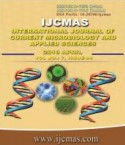


 National Academy of Agricultural Sciences (NAAS)
National Academy of Agricultural Sciences (NAAS)

|
PRINT ISSN : 2319-7692
Online ISSN : 2319-7706 Issues : 12 per year Publisher : Excellent Publishers Email : editorijcmas@gmail.com / submit@ijcmas.com Editor-in-chief: Dr.M.Prakash Index Copernicus ICV 2018: 95.39 NAAS RATING 2020: 5.38 |
A study was carried out in the Department of Soil Science, DRPCAU, Pusa, Bihar during 2014-15 to evaluate physiological properties of Rhizobium isolated from winged bean, pea, gram, lentil and moong. Production of indole acetic acid (IAA), resistance to antibiotics and tolerance to variable pH are some important key concerns for its adaptability to various soil conditions as inoculants. Rhizobia, in general, followed a similar trend towards pH tolerance in terms of growth (measured as OD) i.e., their growth was higher around neutral pH. The per cent increase or decrease in original pH of the broth due to growth of rhizobia was maximum at extremity (at pH 4.0 or 9.0). At pH 7.0 all rhizobia grew profusely. Growth of rhizobia was either positively or negatively influenced by the change in pH. However, moong showed better adaptability in between pH 5.0 to 7.0. IAA production by winged bean Rhizobium was highest among the tested rhizobia. Production of IAA increased with the age of the culture. Moong Rhizobium produced lowest amount of IAA. Both winged bean and lentil rhizobia were resistant to Vancomycin (30µg) while pea and moong rhizobia were resistant to both Ampicillin (10µg) and Nalidixic acid (30µg) as measured using bio-dices. Gram Rhizobium was observed to be resistant to both Chloramphenicol (30µg) and Clarithromycin (15µg). Varying degree of susceptibility to antibiotics was observed for all five rhizobia and all of them were highly susceptible to Tetracycline (30µg).
 |
 |
 |
 |
 |